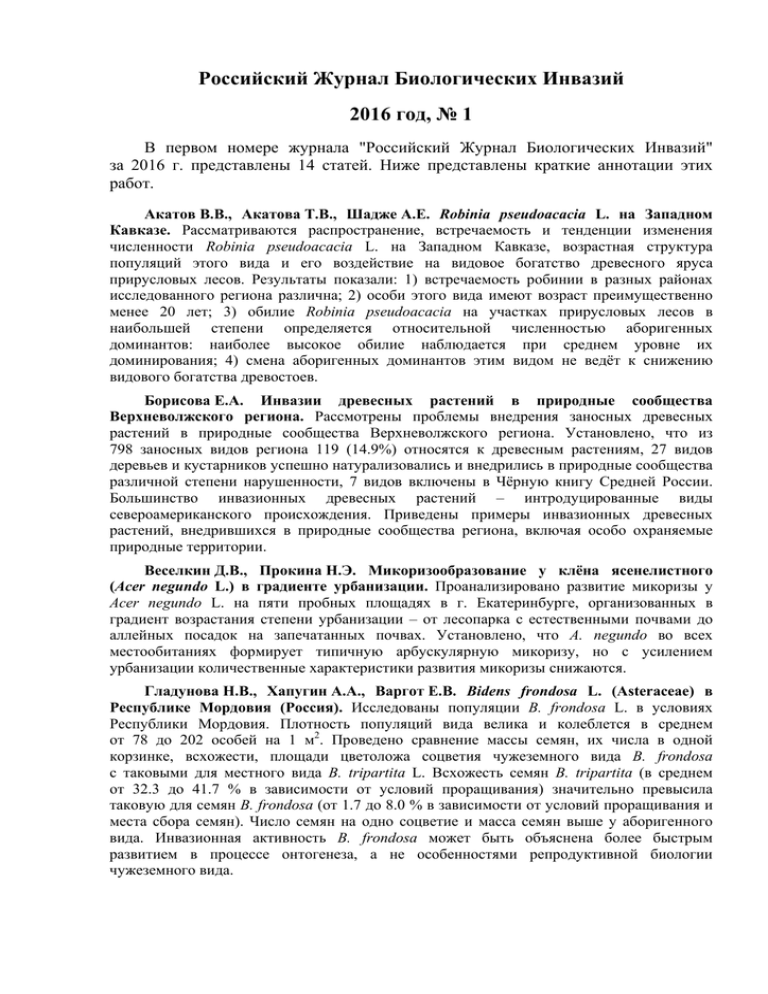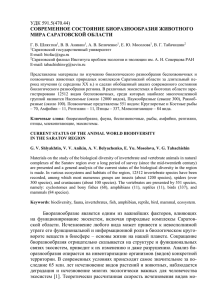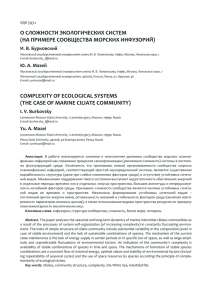Российский Журнал Биологических Инвазий 2016 год, № 1
advertisement

Российский Журнал Биологических Инвазий 2016 год, № 1 В первом номере журнала "Российский Журнал Биологических Инвазий" за 2016 г. представлены 14 статей. Ниже представлены краткие аннотации этих работ. Акатов В.В., Акатова Т.В., Шадже А.Е. Robinia pseudoacacia L. на Западном Кавказе. Рассматриваются распространение, встречаемость и тенденции изменения численности Robinia pseudoacacia L. на Западном Кавказе, возрастная структура популяций этого вида и его воздействие на видовое богатство древесного яруса прирусловых лесов. Результаты показали: 1) встречаемость робинии в разных районах исследованного региона различна; 2) особи этого вида имеют возраст преимущественно менее 20 лет; 3) обилие Robinia pseudoacacia на участках прирусловых лесов в наибольшей степени определяется относительной численностью аборигенных доминантов: наиболее высокое обилие наблюдается при среднем уровне их доминирования; 4) смена аборигенных доминантов этим видом не ведёт к снижению видового богатства древостоев. Борисова Е.А. Инвазии древесных растений в природные сообщества Верхневолжского региона. Рассмотрены проблемы внедрения заносных древесных растений в природные сообщества Верхневолжского региона. Установлено, что из 798 заносных видов региона 119 (14.9%) относятся к древесным растениям, 27 видов деревьев и кустарников успешно натурализовались и внедрились в природные сообщества различной степени нарушенности, 7 видов включены в Чёрную книгу Средней России. Большинство инвазионных древесных растений – интродуцированные виды североамериканского происхождения. Приведены примеры инвазионных древесных растений, внедрившихся в природные сообщества региона, включая особо охраняемые природные территории. Веселкин Д.В., Прокина Н.Э. Микоризообразование у клёна ясенелистного (Acer negundo L.) в градиенте урбанизации. Проанализировано развитие микоризы у Acer negundo L. на пяти пробных площадях в г. Екатеринбурге, организованных в градиент возрастания степени урбанизации – от лесопарка с естественными почвами до аллейных посадок на запечатанных почвах. Установлено, что A. negundo во всех местообитаниях формирует типичную арбускулярную микоризу, но с усилением урбанизации количественные характеристики развития микоризы снижаются. Гладунова Н.В., Хапугин А.А., Варгот Е.В. Bidens frondosa L. (Asteraceae) в Республике Мордовия (Россия). Исследованы популяции B. frondosa L. в условиях Республики Мордовия. Плотность популяций вида велика и колеблется в среднем от 78 до 202 особей на 1 м2. Проведено сравнение массы семян, их числа в одной корзинке, всхожести, площади цветоложа соцветия чужеземного вида B. frondosa с таковыми для местного вида B. tripartita L. Всхожесть семян B. tripartita (в среднем от 32.3 до 41.7 % в зависимости от условий проращивания) значительно превысила таковую для семян B. frondosa (от 1.7 до 8.0 % в зависимости от условий проращивания и места сбора семян). Число семян на одно соцветие и масса семян выше у аборигенного вида. Инвазионная активность B. frondosa может быть объяснена более быстрым развитием в процессе онтогенеза, а не особенностями репродуктивной биологии чужеземного вида. Головина И.В., Гостюхина О.Л., Андреенко Т.И. Особенности метаболизма в тканях моллюска-вселенца в Чёрное море Anadara kagoshimensis (Tokunaga, 1906) (Bivalvia: Arcidae). Проведено сравнение показателей антиоксидантной системы, углеводного, белкового и энергетического обмена в тканях двустворчатого моллюскавселенца Anadara kagoshimensis. Установлена тканевая специфика исследованных параметров, показано, что нога анадары наряду с гепатопанкреасом и жабрами является важным метаболическим органом с высоким уровнем обмена и антиоксидантной защиты. Содержание низкомолекулярных биоантиоксидантов и активность антиоксидантных ферментов в исследованных тканях моллюска специфически сбалансировано. Обсуждаются поведенческие, физиологические и биохимические предпосылки успеха инвазии анадары в Азово-Черноморском бассейне. Гураль-Сверлова Н.В., Глеба В.Н. Свидетельства неоднократного проникновения Cryptomphalus aspersa (Gastropoda, Pulmonata, Helicidae) на территорию Восточной Европы. Проанализированы литературные источники и коллекционные материалы, свидетельствующие о неоднократном проникновении средиземноморского наземного моллюска Cryptomphalus aspersa на территорию Восточной Европы. Во второй половине XIX – начале XX в. моллюсков этого вида находили в Крыму (Феодосия), Северном Причерноморье (Одесса, Херсон) и даже в лесостепной зоне Украины (в окрестностях Винницы). Последнее указание подтверждается раковиной, хранящейся в малакологической коллекции Государственного природоведческого музея НАН Украины. Очевидно, преднамеренная или случайная интродукция C. aspersa на территорию Восточной Европы продолжалась и позднее, однако до сих пор отсутствуют данные, подтверждающие образование устойчивых колоний. Как пример случайного завоза этого вида описана находка 2 особей в г. Виноградов (Закарпатская область Украины), сделанная одним из авторов статьи в 2014 г. Жигалин А.В., Хританков А.М. Об изменении границы распространения вечерницы рыжей Nyctalus noctula Schreber, 1775 (Mammalia, Chiroptera, Vespertilionidae) в Сибири. На основе анализа материалов о распространении рукокрылых в Сибири (личные данные, музейные коллекции, литературные источники) показано значительное смещение к востоку границы ареала вечерницы рыжей Nyctalus noctula Schreber, 1775 до р. Енисей. Высказывается гипотеза о возможном влиянии волн численности и изменения климата на расселение этого вида. Интересова Е.А. Чужеродные виды рыб в бассейне Оби. К настоящему времени известно о 22 чужеродных видах рыб в бассейне Оби. Из них 9 видов образовали самовоспроизводящиеся популяции в естественных водоёмах и начали саморасселение: судак Sander lucioperca, лещ Abramis brama, сазан Cyprinus carpio, верховка Leucaspius delineatus, уклейка Alburnus alburnus, амурский чебачок Pseudorasbora parva, ротан Perccottus glenii, вьюн Никольского Misgurnus nikolskyi и малая южная колюшка Pungitius platygaster. В настоящей работе обобщены данные по инвазии чужеродных видов рыб в бассейне Оби. Приводятся сведения по истории, скорости расселения, современному распространению и относительной численности. Показано, что основным фактором среды, сдерживающим экспансию интродуцентов в бассейне Оби, является температура воды. Капитонова О.А., Капитонов В.И. Первая находка Typha austro-orientalis (Typhaceae) в Удмуртской Республике. Представлены материалы о находке рогоза юговосточного (Typha austro-orientalis Mavrodiev, Typhaceae) на прибрежном мелководье старицы р. Камы в пределах Удмуртской Республики. Дана характеристика биотопа, приводятся некоторые морфологические параметры диагностических признаков растений выявленной популяции. Сёмин В.Л., Сикорский А.В., Коваленко Е.П., Булышева Н.И. Вселение представителей рода Marenzelleria Mesnil, 1896 (Polychaeta: Spionidae) в дельту Дона и Таганрогский залив. В ходе мониторинговых исследований в дельте р. Дон и Таганрогском заливе обнаружены полихеты сем. Spionidae, относящиеся к не отмеченному ранее из Азово-Черноморского бассейна роду Marenzelleria Mesnil, 1896, встречающемуся, как правило, в морских биотопах с разной степенью распреснения. Полихеты отмечались в пробах, отобранных в марте – апреле и ноябре 2014 г. Приводится описание собранных взрослых экземпляров и нектохет, выделяется два морфотипа, обсуждается их возможная видовая принадлежность, вероятные последствия вселения этих полихет. Предполагаемым путём проникновения этих видов является транспорт пелагических личинок с балластными водами из Балтийского или Северного моря. Силаева Т.Б., Агеева А.М. Чужеродные виды флоры в бассейне реки Мокши. Приводятся данные о видовом составе чужеродной флоры бассейна Мокши в пределах Приволжской возвышенности. Отмечены редкие и вновь выявленные виды. Выделены группы заносных видов по времени, способу заноса и степени натурализации. Доминируют во флоре азиатские, средиземноморские виды, значительна группа американских растений. Приводятся списки растений бассейна, включённые в Чёрную книгу флоры Средней России. Показаны различия в характере натурализации случайно и преднамеренно интродуцированных видов. Перечислены инвазионные растения, отмечены особенности их распространения в пределах изученной территории. Фоминых А.С., Мухутдинов В.Ф., Киприянова Л.М. Находки бразильской элодеи в водоёмах-охладителях Верхнетагильской ГРЭС (Средний Урал). В статье приведены данные о находках вида-вселенца бразильской элодеи Egeria densa на Среднем Урале в двух водоёмах-охладителях Верхнетагильской ГРЭС. Предполагаемая причина появления E. densa в водоёмах-охладителях – занос из аквариумной культуры. Шаповалов М.И., Сапрыкин М.А. Чужеродный вид Pistia stratiotes L. (Araceae) в водоёмах урбанизированной территории юга России. Впервые в водоёмах Адыгеи (Северо-Западный Кавказ) обнаружен чужеродный вид африканского происхождения – пистия телорезовидная Pistia stratiotes L. (Araceae). В 2014 г. в двух прудах на территории города Майкопа отмечены скопления растений по 16–34 розетки на поверхности воды, а также плотные куртины площадью до 1 м2 каждая в прибрежной зоне водоёмов. Предполагаемая причина появления пистии на урбанизированной территории – занос из аквакультуры. Находка пистии в Адыгее является самой южной для территории России. Яковлева Г.А., Лебедева Д.И., Иешко Е.П. Первое обнаружение Apophallus müehlingi (Jägerskiöld, 1899) Lühe, 1909 (Trematoda, Heterophyidae) в Карелии. Впервые приводятся сведения об обнаружении Apophallus müehlingi (Jägerskiöld, 1899) Lühe, 1909 у чайковых птиц Ладожского озера и его морфологическая характеристика. У сизой чайки паразит встречался чаще, единично трематоды найдены у малой чайки. Зрелые черви A. müehlingi были обнаружены только у этих видов чаек весной, непосредственно после возвращения с мест зимовки. Обнаружение паразита свидетельствует о потенциальной экологической угрозе. В настоящее время A. müehlingi отмечен только у окончательного хозяина, однако с проникновением в Ладожское озеро брюхоногих моллюсков Lithoglyphus naticoides Pfeiffer, 1828, первого промежуточного хозяина, сформируются условия для реализации жизненного цикла паразита, в результате чего получит широкое распространение апофаллёз – опасное для рыб заражение метацеркариями этих трематод. Russian Journal of Biological Invasions, 2016, issue 1 The first issue of the Russian Journal of Biological Invasions (2016) presents 14 articles. The brief summaries of these articles are presented below. Akatov V.V., Akatova T.V., Shadzhe A.E. Robinia pseudoacacia L. in the Western Caucasus. The distribution, frequency of occurrence and tendency in number change of Robinia pseudoacacia L. in the Western Caucasus, the age structure of populations and influence of this species on arboreal species diversity of riparian forests are analyzed. The results show that 1) occurrence of Robinia pseudoacacia L. in different regions of the area studied is different; 2) most individuals of this species are less than 20 years old; 3) the abundance of Robinia pseudoacacia L. on areas of riparian forests at the greater extent depends on relative abundance of native dominants: the highest abundance is seen at a middle level of their dominance; 4) replacement of native dominants by Robinia pseudoacacia L. does not lead to reduction in arboreal species diversity of forest stands. Borisova E.A. Woody plant invasions into the Upper Volga natural communities. The questions of woody invasive plant introductions into natural communities of the Upper Volga region are considered. It is established that from 798 alien species of the region, 119 (14.9%) refer to woody plants, 27 arboreal and shrub species are successfully naturalized and intruded into natural communities of various degree of disturbance, 7 species are included into the Black Book of Middle Russia. The majority of invasive woody plants are the species of Northern American origin. The examples of invasive woody species introduced into plant communities of the region including the specially protected natural territories are given. Veselkin D.V., Prokina N.E. Mycorrhiza formation in ash-leaf maple (Acer negundo L.) within gradient of urbanization. The development of Acer negundo L. mycorrhiza on five sample plots in Ekaterinburg is analyzed. The plots were organized in urbanization gradient: from a forest park on natural soils to roadside landings on sealed soils. We have found that in all habitats A. negundo L. forms a typical arbuscular mycorrhiza. However, with the increasing of urbanization the mycorrhiza quantitative characteristics are reducing. Gladunova N.V., Khapugin A.A., Vargot E.V. Bidens frondosa L. (Asteraceae) in Republic of Mordovia (Russia). Bidens frondosa L. populations were studied in Republic of Mordovia. Density of populations of invasive species is high and it fluctuates at average from 78 to 202 individuals per 1 m2. A comparison of the seed weight, the number of seeds per calathidium, the seed germination and the area of torus of calathidium of alien B. frondosa L. with those for native B. tripartita L. was carried out. Seed germination of B. tripartita L. (in average from 32.3 to 41.7 % depending on generation conditions) is considerably higher than that for B. frondosa L. (from 1.7 to 8.0 % depending on germination conditions and the sites of seed harvesting). Number of seeds per calathidium and seed weight is higher in population of native species. Invasive activity of B. frondosa L. may be explained by more rapid development during ontogeny but not by peculiarities of reproductive biology of this alien species. Golovina I.V., Gostyukhina O.L., Andreyenko T.I. Peculiarities of metabolism in tissues of clam-invader into the Black Sea Anadara kagoshimensis (Tokunaga, 1906) (Bivalvia: Arcidae). A comparison of parameters of antioxidant system, carbohydrate, protein and energy metabolism in the tissues of invader, bivalve mollusk Anadara kagoshimensis, was carried out. Tissue specificity of the parameters examined was found. It was shown that the foot of anadara along with hepatopancreas and gills was an important metabolic organ with high level of metabolism and antioxidant defense. The content of low molecular bioantioxidants and antioxidant enzymes activity was specifically balanced in the examined tissues of mollusk. The behavior, physiological and biochemical preconditions of anadara’s successful invasion in the Black Sea - Azov basin are discussed. Gural-Sverlova N.V., Gleba V.N. Evidences of repeated penetration of Cryptomphalus aspersa (Gastropoda, Pulmonata, Helicidae) into territory of Eastern Europe. The literature sources and collection materials evidenced about the repeated penetration of the Mediterranean land mollusc Cryptomphalus aspersa into the territory of Eastern Europe were analysed. In the second half of the 19th – the beginning of the 20th century the molluscs of this species were found in the Crimea (Feodosia), North Black Sea area (Odessa, Kherson) and even in the foreststeppe zone of Ukraine (in the environs of Vinnitsa). The last indication was confirmed by the shell, preserved in the malacological collection of the State Museum of Natural History (Lviv). The intentional or accidental introduction of C. aspersa into the territory of Eastern Europe apparently continued later on, however, the data confirming the formation of the steady colonies are still absent. The finding of two specimens in the town of Vinodragov (Transcarpatian region of Ukraine), made by one of the authors in 2014, is an example of unintentional delivery of this species. Zhigalin A.V., Khritankov A.M. Change in dictribution area boundary of common noctule Nyctalus noctula Schreber, 1775 in Siberia. On the basis of Chiroptera distribution area analysis in Siberia (personal data, museum collections, and literary sources), a significant shift of range boundary for the common noctule, Nyctalus noctula Schreber, 1775 to the east until the Yenisei River is demonstrated. A hypothesis about possible influence of number waves and climate change on the dispersion of this species is considered. Interesova E.A. Non-native freshwater fish species in the Ob River basin. To date 22 alien freshwater fish species are known in the Ob basin. From them, nine species have formed self-sustaining populations in natural waters and begun to disperse: the Sander lucioperca, the Abramis brama, the Cyprinus carpio, the Alburnus alburnus, the Leucaspius delineatus, the Pseudorasbora parva, the Perсcottus glenii, the Misgurnus nikolskyi and the ungitius platygaster. This paper summarizes the fata on invasion of alien fish species in the Ob River basin. The data on the history, speed of dispersion, modern distribution and relative number are given. It is shown that the main environmental factor, which constrained invader species expansion in the Ob basin, is the water temperature during the spawning period. Kapitonova O.A., Kapitonov V.I. The first record of Typha austro-orientalis (Typhaceae) in Udmurt Republic. The data on finding of Typha austro-orientalis Mavrodiev (Typhaceae) in the shallow riverside waters of oxbow of the Kama River in Udmurt Republic are given. The characteristics of the biotope and some morphological parameters of diagnostic features of plants for identified population are described. It is assumed that this species has the status of invasive plant in the region. Syomin V.L., Sikorski A.V., Kovalenko E.P., Bulysheva N.I. Penetration of genus Marenzelleria (Polychaeta: Spionidae) into the Don River estuary and the Taganrog bay. During the monitoring investigations in the Don River estuary and the Taganrog bay, two alien polychaete species of the genus Marenzelleria Mesnil, 1896 (fam. Spionidae) were recorded. Adult specimens were collected in March – April and November 2014. Also, high abundances of spionid nectochaetes supposedly belonging to these species were recorded in February 2014 in the Taganrog bay. Descriptions of present adult and larval specimens are given, and two morphological groups are distinguished, followed by the discussion of their identity and possible results of their settling. Probable way of their penetration is transferring of pelagic larval stages from the Baltic or North seas in ballast water tanks, for many tankers use to spill their ballast waters in this area. Silaeva T.B., Ageeva A.M. Flora alien species in the Moksha River basin. Data on species composition of the alien flora of the Moksha River basin within Privolzhskaya Vozvyshennost’ are given. Rare and newly revealed species are recorded. The groups of alien species are identified according to the way of introduction, time introduction and degree of naturalization. Asian and Mediterranean species dominate in all of flora, and the group of American plants is also considerable. The lists of plants of the basin included into the Black Data Book of the Central Russian flora are presented. The differences in the character of naturalization between accidently and intentionally introduced species are shown. Invasive plants are listed, and the features of their distribution within the area studied are noted. Fominykh A.S., Mukhutdinov V.F., Kipriyanova L.M. Findings of Brazilian elodea in cooling reservoirs of Verkhnij-Tagil Power Plant (Middle Ural). The paper presents the data on the findings of the alien species of Brazilian elodea, Egeria densa, in two cooling reservoirs of the Verhnij Tagil Power Plant (the Middle Ural). The most probable reason of the appearance of E. densa in the cooling reservoirs is introduction from aquarium culture. Shapovalov M.I., Saprykin M.A. Alien species Pistia stratiotes L. (Araceae) in water bodies of urbanized territories of southern Russia. For the first time, an alien plant species of African origin – water lettuce (Pistia stratiotes L.) was identified in the ponds of the Republic of Adyghea (the Northern-Western Caucasus). In 2014, we marked accumulations of plants with 16–34 rosettes on the water surface of reservoirs in the territory of the city of Maikop, as well as continuous clumps of the plant up to 1 m2 in area each in the coastal zone of water bodies. The suggested cause of water lettuce appearance in the urbanized territory is its introduction from aquaculture. Finding of water lettuce in Adygei is the southernmost one on the territory of Russia. Yakovleva G.A., Lebedeva D.I., Ieshko E.P. The first finding of Apophallus müehlingi (Jägerskiöld, 1899) Lühe, 1909 (Trematoda, Heterophyidae) in Karelia. The data about finding of Apophallus müehlingi (Jägerskiöld, 1899) Lühe, 1909 in gulls of Lake Ladoga and its morphological characteristics are given for the first time. In Larus canus this parasite occurred more often, in L. minutus trematodes were found as single specimens. Mature A. müehlingi were registered only in those species of gulls in the spring, immediately after their returning from the wintering areas. Detection of the parasite indicates a potential environmental threat. A. müehlingi is revealed only in definitive host at the present time. However, the penetration of gastropods Lithoglyphus naticoides Pfeiffer, 1828, the parasite’s first intermediate host, into Lake Ladoga will form conditions for the realization of the life cycle of the parasite. This can lead to the A. müehlingi epizooty of fish.

